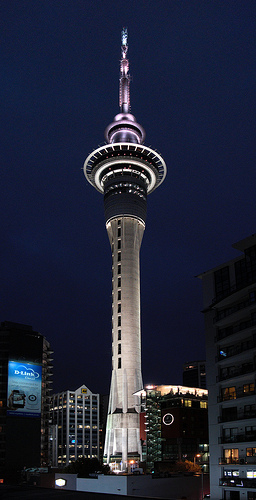What do you know about the Sky Tower in Auckland?
- It took two years and nine months to build Sky Tower
- The Sky Tower has three circular public observation levels – Sky Deck, Main Observation level and Sky Lounge – from each of which you can get a 360-degree view of Auckland
- Three glass-fronted elevators can take 225 people to the observation levels every 15 minutes. The elevators travel at 18km per hour and the ride takes only 40 seconds
- There are 1,267 steps from the base of Sky Tower to Sky Deck. It would take someone 29 minutes to reach Sky Deck walking at 4km (2.5 mph)
- On a clear day you can see approximately 82 kilometres (51 miles) from Sky Tower. That’s as far north as Leigh Peninsula, as far east as Great Barrier Island, as far west as the Waitakere Ranges, and as far south as the Bombay Hills
- In 2009 the record was broken for the fastest run up the Sky Tower. Thomas Dold from Germany set an astounding record of 4 minutes 53 seconds.
Construction facts
- The Sky Tower consists of 15,000 cubic metres of concrete, 2,000 tonnes of reinforcing steel and 600 tonnes of structural steel – including 170 tonnes in the mast
- Sky Tower is constructed from a high strength, high performance concrete
- The foundations go down more than 15 metres and are designed to spread force load
- It has been designed to remain essentially undamaged during storms with winds gusting to 200 km/hr (125 mph), which can result in sway at the top of the concrete shaft of approximately one metre
- In the extreme event of a magnitude 8.0 earthquake occurring within 20 kilometres of the tower, analysis shows that Sky Tower would remain standing.
Straight up
- During construction constant verification was necessary to ensure Sky Tower was perfectly straight. This telemetry encompassed three key techniques
- The first is called ‘resection’ where measurements were taken from three different existing points surrounding Sky Tower – in this case the ASB Bank building, Mount Eden and the Coopers and Lybrand building – to find the precise centre point of the structure
- During construction of the shaft, lasers positioned on the base pad of Sky Tower were shone up to the jump platform in a grid pattern to provide vertical readings
- Finally, daily real-time readings were taken of the structure using seven global positioning satellites to confirm the exact position of Sky Tower




